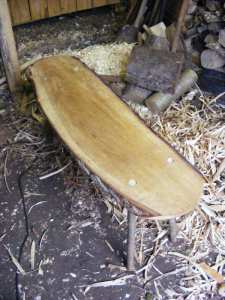
I don’t much care for big crowds at shows and normally I try to avoid them, but the New Forest Show is an exception that proves the rule. It’s a small big show, by which I mean that it still has a bit of a small feel and a larger element of traditional and rural crafts than some shows. Though it’s still pretty big and there are many acres of trade stands. I was with the Hampshire Coppice Craftsmen Group and we set up our pimps, faggots and benders at the village green end of the show.

Traditionally benders were made using bentwood poles, scavenged from the roadside hedges and a tarp covering, often more tar than paulin. Our shelters are more conveniently made with straight poles and the Hampshire group pitch accommodated a range of polelathes, hurdle and spar making and not least the faggots and pimps, of which more later.
Just around the corner from the Hampshire group members of the Dorset coppice group were demonstrating. Terry Heard makes besom brooms under the awning of his fabulous living wagon. Living vans were similar to shepherd’s huts but larger and better appointed, being intended to be towed behind a traction engine.

Terry was also making tent pegs with a traditional stock knife and the rounds of ash quickly transformed themselves into neat stacks of tent pegs.

This superb collection of bill hooks, axe heads and other greenwood working tools caught my eye. The collection includes billhooks from the Moss family of blacksmiths in Surrey and Sussex and some Somerset Fussell’s hooks.

This display of woodsman’s tools included a very nice U shaped shave for shaving the bark from poles. It caught my interest as I have an almost identical one that a friend donated to me. They are all hand made, often from old files and I was suprised how similar the two tools were. As we chatted I learnt that the tool had belonged to his grandfather and despite many offers he is not selling it. Meanwhilst the net he is making will be used for working with his ferrets.

Back at the Hampshire stand Alan Waters was converting a trailer load of birch faggots into a load of pimps. The traditional Sussex oimp is a handful of birch spray and cleft branch wood, firelighter and kindling in a single bundle. Each bundle of birch is chopped to length using a pimp cleaver, a massive single handed chopper with the birch clamped on a purpose built stand.

Twenty five bundles are then tightly compressed in a pimping engine and then tied with cord to make the roll.
A brief rest from wielding the enormous pimp cleaver. The strange alloy wheel is the front of Allan’s new Mare. A mare is a traditional barrow for use in the woods with an open frame for carrying cord, poles and faggots and a much larger wheel for coping with the rough ground. I’ve been meaning to make one for some time. both for using at my charcoal site and also for use at shows so seeing Alan’s has spurred me onto another project.












































